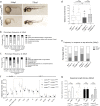Targeted resequencing identifies genes with recurrent variation in cerebral palsy
- PMID: 31700678
- PMCID: PMC6828700
- DOI: 10.1038/s41525-019-0101-z
Targeted resequencing identifies genes with recurrent variation in cerebral palsy
Abstract
A growing body of evidence points to a considerable and heterogeneous genetic aetiology of cerebral palsy (CP). To identify recurrently variant CP genes, we designed a custom gene panel of 112 candidate genes. We tested 366 clinically unselected singleton cases with CP, including 271 cases not previously examined using next-generation sequencing technologies. Overall, 5.2% of the naïve cases (14/271) harboured a genetic variant of clinical significance in a known disease gene, with a further 4.8% of individuals (13/271) having a variant in a candidate gene classified as intolerant to variation. In the aggregate cohort of individuals from this study and our previous genomic investigations, six recurrently hit genes contributed at least 4% of disease burden to CP: COL4A1, TUBA1A, AGAP1, L1CAM, MAOB and KIF1A. Significance of Rare VAriants (SORVA) burden analysis identified four genes with a genome-wide significant burden of variants, AGAP1, ERLIN1, ZDHHC9 and PROC, of which we functionally assessed AGAP1 using a zebrafish model. Our investigations reinforce that CP is a heterogeneous neurodevelopmental disorder with known as well as novel genetic determinants.
Keywords: Genetic testing; Molecular medicine; Neurodevelopmental disorders; Paediatric neurological disorders.
© The Author(s) 2019.
Conflict of interest statement
Competing interestsThe authors declare no competing interests.
Figures


References
-
- Surveillance of Cerebral Palsy in Europe (SCPE) Prevalence and characteristics of children with cerebral palsy in Europe. Dev. Med. Child Neurol. 2002;44:633–640. - PubMed
LinkOut - more resources
Full Text Sources
Molecular Biology Databases
Miscellaneous

